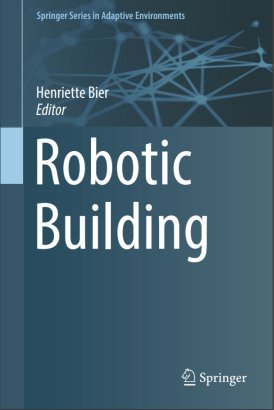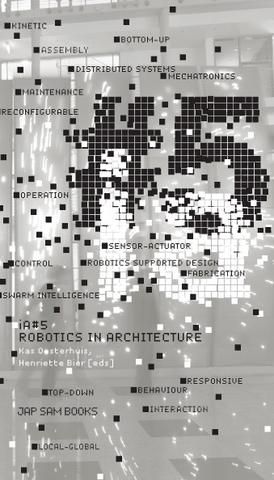BOOKS
Disruptive Technologies: The Convergence of New Paradigms in Architecture
Philippe Morel (Ed.), Henriette Bier (Ed.)
Series: Springer Series in Adaptive Environments
- Presents hypotheses and arguments about the influence of technologies on architecture and urban design
- Includes some of the most acclaimed voices in architectural theory, education, and practice
- Brings essential references to students, scholars and practitioners, interested in built environment
Through a series of highly speculative contributions by both leading and highly acclaimed practitioners and theorists, this book gives a new comprehensive overview of architectures’ most recent practical and theoretical developments.
While a few chapters are mostly dedicated to a historical analysis of how we got to experience a new technological reality in architecture and beyond, all chapters including the most forward looking, have in common their rigorous understanding of history as a pool of radical experiments, whether one speaks of the history of architecture, or of sociology, technology, and science.
Disruptive Technologies: The Convergence of New Paradigms in Architecture is required reading for anybody student, practitioner, and educator who wants to do serious research in architecture and all disciplines dealing with the shaping of our environment, beyond the important but restricted domain of computational architectural design.
Additional multimedia content via app: download the SN More Media app for free, scan a link with play button and access to the Additional Contents directly on your smartphone or tablet.
https://link.springer.com/book/10.1007/978-3-031-14160-7
Disruptive Technologies: The Convergence of New Paradigms in Architecture
Philippe Morel (Ed.), Henriette Bier (Ed.)
Series: Springer Series in Adaptive Environments
- Presents hypotheses and arguments about the influence of technologies on architecture and urban design
- Includes some of the most acclaimed voices in architectural theory, education, and practice
- Brings essential references to students, scholars and practitioners, interested in built environment
Through a series of highly speculative contributions by both leading and highly acclaimed practitioners and theorists, this book gives a new comprehensive overview of architectures’ most recent practical and theoretical developments.
While a few chapters are mostly dedicated to a historical analysis of how we got to experience a new technological reality in architecture and beyond, all chapters including the most forward looking, have in common their rigorous understanding of history as a pool of radical experiments, whether one speaks of the history of architecture, or of sociology, technology, and science.
Disruptive Technologies: The Convergence of New Paradigms in Architecture is required reading for anybody student, practitioner, and educator who wants to do serious research in architecture and all disciplines dealing with the shaping of our environment, beyond the important but restricted domain of computational architectural design.
Additional multimedia content via app: download the SN More Media app for free, scan a link with play button and access to the Additional Contents directly on your smartphone or tablet.
https://link.springer.com/book/10.1007/978-3-031-14160-7
Robotic Building
Henriette Bier (Ed.)
Series: Springer Series in Adaptive Environments
- Treats both theoretical and practical aspects of robotics in architecture
- Focuses on design-to-robotic-production and -operation
- Reviews exhaustively the key recent research into robotic systems, reconfigurable structures and architectured materials
The first volume of the Adaptive Environments series focuses on Robotic Building, which refers to both physically built robotic environments and robotically supported building processes. Physically built robotic environments consist of reconfigurable, adaptive systems incorporating sensor-actuator mechanisms that enable buildings to interact with their users and surroundings in real-time. These require Design-to-Production and Operation chains that are numerically controlled and (partially or completely) robotically driven. From architectured materials, on- and off-site robotic production to robotic building operation augmenting everyday life, the volume examines achievements of the last decades and outlines potential future developments in Robotic Building. This book offers an overview of the developments within robotics in architecture so far, and explains the future possibilities of this field. The study of interactions between human and non-human agents at building, design, production and operation level will interest readers seeking information on architecture, design-to-roboticproduction and design-to-robotic-operation.
http://www.springer.com/gp/book/9783319708652
iA#5 - Robotics in Architecture
Kas Oosterhuis, Henriette Bier [eds]
The theme of iA#5 is Robotics in Architecture
Understanding buildings from a life-cycle perspective with respect to their economical and ecological impact on society at large requires the development of unprecedented concepts and practical applications for interactive, robotic architecture, leading to the emergence of active and pro-active building components, which act and interact in ever-changing environments. Furthermore, this requires the development of seamless, robotics supported design, fabrication, assembly, operation and maintenance processes. The fifth IA issue on robotics addresses all these aspects on some level focusing on reconfigurable architecture that is incorporating sensing-actuating mechanisms in order to enable buildings to interact with their users and surroundings.
https://www.japsambooks.nl/products/ia-5-robotics-in-architecture



